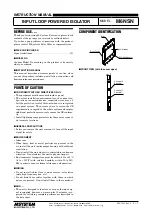
16
Section 4: Genesis Control Options and
Examples
The TraceNet system allows a variety of control options for
heat trace operation.
•
Line sensing (RTD Sensor on pipe-wall)
•
APC (Ambient Proportional Control)
•
Ambient Sensing (On-Off Control)
The most energy efficient control mode is to use one (or
more) line sensing RTD’s for each heat trace circuit. When
using this control mode, the TraceNet Genesis panel will
have the RTD(s) connected to the DTM module in the
panel.
4.1: Line Sensing Control
When the RTD is directly sensing pipe-wall surface for
control, the key parameters are “Maintain Temperature” at
which the heat trace is energized or turned on. The “Max”
temp setting is where the heat trace will be de-energized,
or turned off. The difference between these control settings
defines the “dead band” (aka “control differential”)
From the line sensing RTD(s) the temperature of the
process line is read by the Genesis and is/are also able
to alarm for the user’s low and high temperature alarm
settings. (A “high-high” temperature setting with circuit
“trip” option is also determined from the RTD(s) placed
directly on the process line.)
Line sensing is the most energy efficient method of control
as the heat trace is only energized when the temperature
of the line is at the “Maintain” setting (or lower) and the
heat trace is de-energized when the it reaches the “Max”
setting, (aka “Maintain” plus “Dead Band”.)
4.2: Ambient Sensing Options
Any ambient sensing control mode is less energy efficient
than line-sensing control, but generally allows fewer
heating circuits of longer lengths. This is because there is
no concern about process flow paths for heating circuit
layout, which will influence RTD placement, the number
of sensors, and the number of heating circuits required.
For the TraceNet Genesis system, and its predecessor
the TCM18, “Proportional Control” refers to a “time
proportioning” function for saving energy or more
accurately controlling maintain temperatures. So, if a given
situation calls for 50% power, then the controller cycles on
and off 50% of the time to achieve this energy delivery.
There is a “Power Clamp” feature for these controllers that
is available when the controller is used with solid-state
relays, and is enabled when a circuit is set for “on/off with
soft start”. This feature literally provides “soft start” using
a reduced on/off duty time cycle of 1 second initiating at
the percentage selected.
There are two options for Ambient Sensing with the
TraceNet Genesis System: Ambient Proportional Control
and Ambient "On-Off" Control.
4.2.1: APC (Ambient Proportional Control)
With APC the heat trace will be set to operate at 100%
power (continuously on) at the minimum ambient
temperature, and reduce power as the ambient
temperature rises to the maintain temperature. When the
ambient temperature reaches the maintain temperature,
the heat trace produces no heat for that circuit. This
“Proportional Control” is achieved by cycling the power
to the heat trace “on” and “off” so the time “on” is
proportional to the difference between the “Maintain”
and ambient temperatures. (
Note:
The minimum power
level is 8%, so that the electrical current and earth leakage
current levels can be accurately measured.)
Example of Ambient Proportional Control (APC):
Ma40°F (+5°C) (i.e. to keep water from freezing) in a
minimum ambient condition of -40°F (-40°C) with APC control
method, follow this procedure:
The “Maintain” Temperature is set at +40°F (+5°C), at which
the heat trace would be de-energized, or “Off”.
The “Minimum Ambient” temperature (at or below which
power is on 100%) would be programmed to be a value of
-40°F (-40°C).
(Note that the difference between the Maintain and the
Minimum Ambient temperature defines the “Dead Band”,
across which the time “on” and “off” is established do deliver
the heat proportionally. The reduced power delivery results
in overall energy consumption when compared to Ambient
“On-Off” Control.)
APC control method can be successfully used for maintaining
elevated temperatures as well. This can reduce the number of
heating circuits by allowing longer heating circuits, but is not
as energy efficient as line sensing RTD temperature control.
The APC control method has traditionally been used only
with Solid State control relays because of rapid cycling of the
control relays during operation. Now, by expanding the cycle
time between “on” and “off”, mechanical relays can be used.
“On/off with soft start” is selected with 100% Power Clamp.
The result is that the circuit will operate in a normal on/off
method.
4.2.2: Ambient “On-Off” Control
In this case the heat trace is fully “on” when the ambient
temperature falls below the “Maintain” temperature and
is fully “off” when the ambient temperature rises above
the “Maintain” plus the minimum control dead band.
Example of "On-Off" Ambient Sensing Control:
As a third control mode option, the TraceNet Genesis panel
may be configured for Ambient “On-Off” Control. In this case,
one or two RTD’s may be used to sense ambient temperature,
typically in a shaded area subject to wind and rain in an area
convenient to the panel location.
In this case, the heat trace operates at 100% power whenever
the ambient temperature drops below the “Maintain”
temperature. To winterize water lines this is typ40 to
50°F (+5 to 10°C). If the ambient rises above this value, plus
the minimum control dead band of +3° (°F or °C)) the heat
trace will turn off.
















































